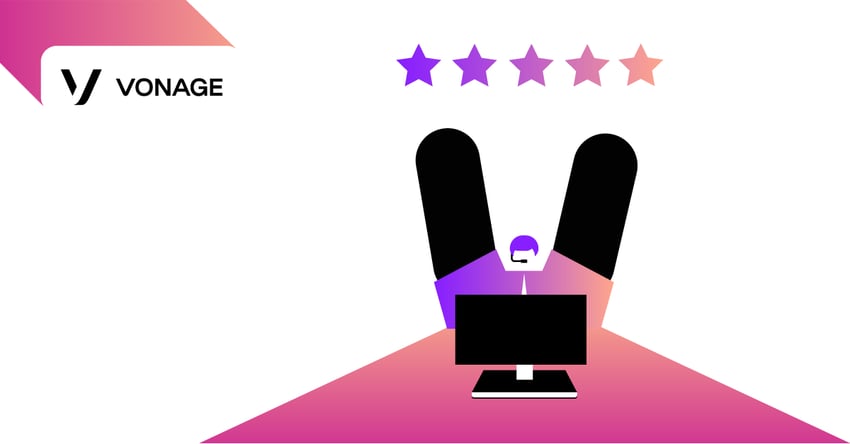AI Customer Experience: Helping Human Agents Work Smarter
Artificial intelligence (AI) isn't a replacement for people. It's a valuable resource that can support existing workforces, enabling a business to work more efficiently and better serve customers. Welcome to the age of the AI customer experience.

For many, artificial intelligence (AI) brings to mind memories of Asimov's "Robot" series, "Battlestar Galactica," or perhaps especially "The Terminator"—futuristic stories in which AI is a threat to human existence. Others have more immediate concerns about how AI might threaten human job security or corporate data security. But AI isn't a replacement for people. It's a valuable resource that can support existing workforces, enabling a business to work more efficiently and better serve customers.
How AI Can Take Customer Experience to the Next Level
The AI customer experience is a big part of how consumers are now interacting with brands and organizations. AI yields insights that help companies deliver what customers want and provides contextual data that helps live agents successfully answer questions and resolve issues faster. Meanwhile, AI options like chatbots and virtual assistants can back up human teams.
These AI customer service improvements can have a significant impact on an organization's success and revenue. According to Forbes and Treasure Data, 74% of consumers will buy from a company based on customer experience alone.
Here's what consumers hope to avoid when they contact a business—and how AI can improve the experience.
Customer Experience Needs a Boost
So, your package didn't arrive on time. Or there's a problem with your bank account. Or you need to renew your driver's license. These are just a few of the situations that will spark a call to customer service.
Unfortunately, at times, this leads to a worst-case scenario: customers navigating a complicated phone tree, being put on hold for a long time, and finally being poorly connected to a customer service representative in a distant country.
It's no wonder that 54% of Americans say most companies need to improve the customer experience, according to PwC.
Companies have been outsourcing their customer support teams, sales teams, and even marketing efforts for years, and that can take a toll on the customer experience. When people contact a business, they want fast answers from someone who knows their stuff—likely an engaged employee who cares about the company and its customers.
Even with on-site contact centers and engaged employees, companies risk delivering a lackluster experience if it takes too long for customers to reach the right person or find the right answer. Still, the combination of AI and helpful human interaction can provide excellent service across the board, without putting a strain on resource costs and the bottom line.
Enter AI Assistants
With AI to back up agents, companies don't need to outsource customer-facing jobs, overburden staff, or make customers wait. Instead of endless phone trees that often send callers to the wrong department, AI can treat customers to an intelligent virtual assistant that answers basic questions, enables self-service, and/or routes callers to the most appropriate person.
While virtual assistants offload callers, chatbots serve customers who reach out to an omnichannel contact center in writing, whether that's via text, messaging apps, or social media sites. Similar to virtual assistants, chatbots can answer questions, complete customer transactions, take secure credit card payments, and escalate complicated questions to human representatives.
Not only does this AI customer experience lighten the load for employees and reduce (or eliminate) the wait time for callers, it also enables a company to offer 24/7 service.
Helping Humans Work Smarter
While chatbots and virtual assistants direct customers to the right person—which saves agents from taking calls with questions they can't answer—machine learning helps agents find answers faster by breaking down data silos and providing context about why customers are reaching out. With the right integrations, AI-based speech recognition technology can also monitor interactions and suggest knowledge resources and next actions to agents. Meanwhile, real-time voice analytics technology can listen for signs of frustration from the customer and escalate the call to a manager if necessary.
AI also helps customer service teams improve their skills by transcribing calls in real-time and analyzing them for actionable insights. This information helps managers spot learning opportunities for individual agents and identify ways to make the whole team more efficient and effective at solving customer problems.
Using AI to Better Understand Customers
AI doesn't just help companies better serve customers; it also helps companies better understand their customers, their needs, and what's important to drive action. During an interaction, this means pulling data about the customer's history from omnichannel sources, so agents know exactly who they're talking to and why. Companies that have implemented similar technologies have experienced increased trust in their brand, more repeat business, and higher rates of customer satisfaction and loyalty.
After the interaction, they can leverage AI-powered conversational surveys to find out how the customer feels about the service they received and about the company in general. Traditional surveys have low response rates and, by design, make assumptions about the customer experience. Conversational surveys using AI, natural language processing, and machine learning engage the customer in a live conversation, where the side representing the company is also responsive and interactive. This allows companies to get specific feedback and individual insights.
By asking follow-up questions, the bot is able to get to the real root of an issue, and companies can use that information to make critical decisions. The customer feels listened to and cared for; as a result, the company is better able to serve them.
In the end, everybody wins with the AI customer experience. And human agents don't get replaced—rather, they get some much-needed virtual assistance.
